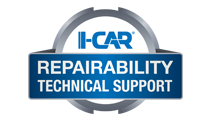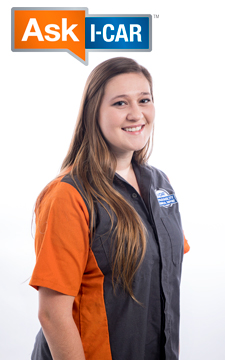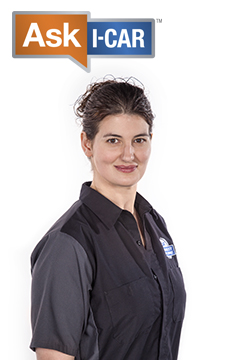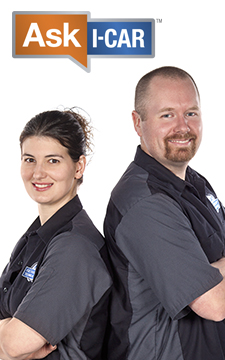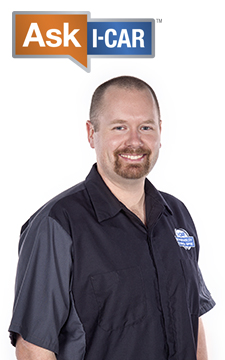Mercedes-Benz Vehicles On The RTS OEM Calibration Requirements Search
Posted on 4 December 2025Mercedes-Benz models are now listed in the OEM Calibration Requirements Search page on the RTS website. You're going to notice a difference between other vehicle search results and Mercedes-Benz vehicles. Let’s take a look at the reason for the differences.
I-CAR OEM Technical Information Matrix: What Is It, And How Does It Help? UPDATE
Posted on 5 December 2024Do you know which vehicle makers have collision repair information available? Do you know where you can go to find that out?
Repairer Driven News: OEM Specifications For Modern Batteries
Posted on 22 July 2024Repairer Driven News (RDN) released an article highlighting 12-volt and 48-volt mild hybrid battery trends in current and upcoming vehicles.
Child Car Seat Resources For Vehicles With Inflatable Seatbelts
Posted on 12 June 2024Ford and Mercedes-Benz vehicles offer an optional inflatable seat belt for rear outward passengers. This unique safety feature presents challenges when installing a child car seat. Let’s see where to locate information.
OEM ADAS Radar Optimized Color Resources: Mercedes-Benz
Posted on 5 June 2024Changes in advanced driver assistance systems (ADAS) radar technology are introducing new refinishing considerations. We know that paint film thickness can affect the performance of ADAS radars, but color formula selection may also be a contributing factor. What resources do repairers have available? Let’s see what Mercedes-Benz has to say.
High-Voltage Vehicle Paint Booth Quick Reference
Posted on 9 April 2024When refinishing high-voltage (HV) vehicles, it is important to check for OEM paint booth temperature recommendations so that HV components do not get damaged in the heat.
48-Volt Mild Hybrid Systems: Mercedes-Benz
Posted on 31 January 2024Mild hybrid systems are not new. They were some of the first hybrid vehicles to be put into production. The 48-volt mild hybrid system is now becoming more common among some vehicle makers. What consideration are there for repairing a vehicle equipped with a 48-volt mild hybrid system? Let’s see what Mercedes-Benz has to say.
Identifying The Correct High-Voltage Disable Procedure: Mercedes-Benz
Posted on 13 October 2023When researching Mercedes-Benz vehicles, you may notice multiple procedures for disabling the high-voltage (HV) system. Let’s see why there are multiple high-voltage disable procedures available from Mercedes-Benz.
OEM Emergency Response Guides: Mercedes-Benz - UPDATE
Posted on 5 October 2023Are you looking for OEM emergency response guides (ERGs)? The Repairability Technical Support (RTS) team has located these guides and either houses them on the RTS website, provides links to webpages that house them, or provides articles with instructions on how to locate them.
One-Time-Use Parts And Fasteners: Mercedes-Benz
Posted on 28 April 2023What is a one-time-use part, and how do you determine if a fastener, clip, or part can be reused? These are questions that we are confronted with in the collision industry quite a lot. The other big question is "Where do I find this information?"
Locating OEM-Approved HV Tools: Mercedes-Benz
Posted on 7 March 2023When researching procedures for disabling a high-voltage (HV) vehicle, you may notice that many of the procedures require the use of specific tools. Some of them are OEM-specific tools or scan tools. Often identifying and locating where to purchase these specific tools can be difficult.
Refinishing Park Assist Sensors: Mercedes-Benz
Posted on 19 January 2023Park assist sensors are part of the park assist system, just one of many advanced driver assistance systems (ADAS) found on vehicles today. Damaged sensors are typically replaced and may require painting to match the vehicle. Vehicle makers often provide information on the painting of new sensors. Some vehicle makers do not recommend refinishing sensors with minor finish damage because excessive paint thickness may adversely affect the operation of the park assist system. However, other vehicle makers allow refinishing and provide guidelines. Let’s see what Mercedes-Benz has to say.
Where Do I Find Other Types Of Information In Mercedes-Benz?
Posted on 23 November 2022Navigating OEM websites can be challenging when searching for collision repair procedures, especially as no two OEM websites are alike. What happens when you need to find other types of repair information, such as, "What needs to be inspected after a supplemental restraints system (SRS) deployment?", or "Does the tire pressure monitoring system (TPMS) require a scan tool or specialty tool?" Let's take a closer look at the Mercedes-Benz website.
Mercedes-Benz: Who Requires Or Recommends MIG Brazing?
Posted on 24 September 2021In Europe, MIG brazing has been required or recommended on a widespread basis for several years. In the U.S., MIG brazing is not as common but is becoming more prevalent. As the RTS team is researching MIG brazing information, we are putting together a series of articles that identify OEM-specific MIG brazing recommendations and requirements for vehicles in the U.S. Let’s see what Mercedes-Benz has to say.
Rivet Guns: Does My Shop Need Them?
Posted on 23 July 2021When performing collision repairs, there are more attachment methods available than ever before. OEMs specify which attachment methods are recommended or required. If a method is not listed as an option, it should not be used.
Steel Spot And Plug Weld Nugget Size: Mercedes-Benz - UPDATE
Posted on 26 May 2021Did you know that some OEMs specify nugget size for spot and plug welds? This information is typically found within vehicle-specific repair procedures or can be found under general welding guidelines. Let’s see what Mercedes-Benz has to say.
Locating ADAS Information: Mercedes-Benz
Posted on 18 May 2021As a collision repair technician, there is one part of a service manual that houses all of the information you would ever need…right? This is not the case with modern vehicles. You may be required to look in numerous manuals to find the information required to safely repair the vehicle.
OEM Emergency Response Guides
Posted on 25 February 2021Are you looking for OEM emergency response guides (ERGs)? The Repairability Technical Support (RTS) team has located these guides and either houses them on the RTS website, provides links to webpages that house them, or provides articles with instructions on how to locate them.
Who Requires Or Recommends MIG Brazing? UPDATE
Posted on 25 November 2020In Europe, MIG brazing has been required or recommended on a widespread basis for several years. In the U.S., MIG brazing is not as common but is becoming more prevalent. As the RTS team is researching MIG brazing information, we are putting together a series of articles that identify OEM-specific MIG brazing recommendations and requirements for vehicles in the U.S.
Non-SRS Wiring Repairs: Mercedes-Benz
Posted on 17 September 2019What is a non-SRS wiring repair? It is the repairing of an electrical component that is not part of the supplemental restraints system circuit (usually identified by yellow wire looms). As technology increases on vehicles, so does the number of components that utilize electricity. Many of the sensors and modules are becoming smarter and more sensitive. If the wire is too long, the wrong gauge, or spliced in the wrong location it can cause malfunctions in the components that it’s powering. Many OEMs have different restrictions and guidelines for repairing wiring that does not control SRS components. On the other hand, there are OEMs that don’t allow wiring repairs at all, so full harness replacement is the only option.
Bumper Cover Repair With ADAS: Mercedes-Benz
Posted on 16 May 2019A simple bumper repair on a modern vehicle may not be as simple as it seems. New technologies like blind spot monitoring, adaptive cruise control, and other advanced driver assistance systems (ADAS) utilize sensors behind the bumper covers. The ability for these sensors to be able to see clearly, normally requires special caution when considering a bumper repair. Many OEMs have different levels of warnings when it comes to repairing bumper covers with ADAS. So, what does Mercedes-Benz say on the subject?
ADAS, Calibration, And Scanning Article Hotspot
Posted on 14 January 2019Since advanced driver assistance systems (ADAS), scanning, and calibration first started becoming relevant, members of the collision repair industry have required as much knowledge as possible on these subjects. I-CAR’s Repairability Technical Support (RTS) team continues to be on the leading edge of research and education. Our goal is to help communicate information to the industry, and a great way to do this is through Collision Repair News articles.
Repairer Driven News: Mercedes-Benz A-Class Sedan
Posted on 26 July 2018The new Mercedes-Benz A-Class sedan is set to arrive later this year. A recent article by Repairer Driven News (RDN) covers many new features the collision repairer industry will need to know.
Additional Calibration Requirements: Mercedes-Benz
Posted on 21 July 2017The addition of the OEM Calibration Requirements Search to the RTS portal was a big step for the collision industry. While this new feature has been well received, there has been some confusion about what is included in the search tool. The OEM Calibration Requirements Search is designed to provide information on the calibration requirements that are needed for vehicles equipped with advanced driver assistance systems (ADAS). This includes systems such as adaptive cruise control, lane keep assist, and collision braking.
Structural Sectioning Procedures: Mercedes-Benz
Posted on 28 June 2017Ask I-CAR receives many technical inquiries referring to sectioning. The collision repair industry wants to know where can you section, does the OEM have a sectioning procedure, and where can I find the sectioning procedure? Most OEMs allow sectioning to outer body panels and the front and rear rails. Sectioning reinforcements is not as common, as most reinforcements are replaced at factory seams.
Corrosion Protection Guidelines: Mercedes-Benz
Posted on 7 June 2017A key factor in collision repair is making long-lasting repairs. When a vehicle is repaired, many areas of corrosion protection are disturbed. This creates corrosion hot spots that left untreated will lead to corrosion and potentially a repair failure. However, there are certain precautions that can be taken to safely and properly restore the corrosion protection throughout the repair process. OEMs often give specifications on restoring corrosion protection. These specifications generally include seam sealer, adhesives, foam fillers, and cavity waxes. Let’s take a look at what Mercedes-Benz says.
What's That in the Grille?
Posted on 11 May 2017Have you noticed anything different looking on new vehicle grilles? If you have, you may have thought what is that strange looking flat spot? Sometimes this flat area is somewhat hidden by a manufacturer emblem. Other times it’s integrated into the grille itself, including grille lines. Let’s take a look at this new design element and what it’s hiding.
Awareness of Changing Refrigerant Types
Posted on 20 April 2017You may have noticed that A/C refrigerant on many new vehicles has started to change. For many years, OEMs used R134a. However, government mandates require OEMs to phase out R134a by the year 2021. This left OEMs scrambling to find a replacement. Many US OEMs chose to use R1234yf to replace R134a, but there are some OEMs that have chosen a different route. Let’s take look at these new refrigerants.
Weld-Through Primer Guidelines: Mercedes-Benz
Posted on 3 April 2017Weld-through primers are generally a zinc-based product that are applied to the mating surfaces prior to welding. Corroding zinc forms zinc oxide which protects the steel. This is called sacrificial corrosion. For a quality weld to be made it’s required that the weld-through primer be removed from the direct weld zone before welding the joint when GMA welding. Many OEMs have a position on when and how to use weld-through primer or when it shouldn’t be utilized. Let’s see what Mercedes-Benz recommends and where this information can be found.
Battery Disconnect Considerations
Posted on 21 February 2017When a damaged vehicle enters a collision repair facility, many times the repairs require the battery to be disconnected. Operations such as welding, SRS repairs, engine work, and body panels being open for extended periods of time, can all require that the battery be disconnected. At one time the radio presets would be written down before the battery was disconnected and programmed after the battery was reconnected. However, today many OEMs have special precautions or steps that need to be taken when disconnecting the battery. Let’s take a look at what some OEMs require when disconnecting the battery.
Mercedes-Benz Position Statement: Steering Components
Posted on 14 December 2016The steering system on a vehicle could be considered one of the most important and necessary systems on a vehicle. After all, without steering the driver couldn’t control the vehicle. This makes it important to know what the OEM recommends when it comes to this system. Let’s take a look at what MBUSA has to say.
Mercedes-Benz Postion Statement: Genuine Replacement Parts
Posted on 9 December 2016Here at I-CAR we receive a lot of question about the use of aftermarket and recycled parts, when repairing a vehicle after a collision. We are not in the position to tell you what parts you can and cannot use. However, some OEMs publish position statements to give guidance as to what they do and do not permit when selecting which parts to use to restore the vehicle to its pre-collision state. Mercedes-Benz (MBUSA) has released an updated position statement to help answer these question. Let’s see what MBUSA has to say in their revised position statement.
Collision Information Website Access: Mercedes-Benz
Posted on 5 December 2016Why do I need a subscription to an OEM website if I have full subscription access to the I-CAR Repairability Technical Support (RTS) portal? This is a question received on a regular basis through Ask I-CAR. Let’s take a look at why and how to purchase an OEM subscription.
Mercedes-Benz Position Statement: Pre- and Post-Repair System Scanning
Posted on 28 November 2016Mercedes-Benz is known for their use of technology in their vehicles. Many of their models are equipped with some of the latest and greatest bells and whistles. So, what does this mean for collision repair technicians when it comes to repairing these vehicles. Let’s see what Mercedes-Benz has to say.
Mercedes-Benz Glass Replacement Requirements
Posted on 23 November 2016The role of the windshield is a lot more complex than simply allowing a view of the road ahead. It is considered a structural part of the vehicle as it contributes to the strength of the roof and A-pillars. The windshield helps to manage collision energy and has become an integral part of several advanced safety systems.
Mercedes-Benz Collision Position Statements Available
Posted on 23 November 2016There's a new addition to the Mercedes-Benz OEM Information. An icon has been added that will link you to a page containing Mercedes-Benz Position Statements.
Always Follow Vehicle Maker Procedures
Posted on 7 July 2016We often receive Ask I-CAR inquiries asking: “what does I-CAR recommend?” Many times these questions are in regards to sectioning, straightening, or part replacement/attachment methods. Our first response is always:
Restraints Wiring Repairs
Posted on 23 May 2016Over the past few months, we've been sharing OEM position statements on restraints wiring repairs. Now we're bringing them all together in one place for easy reference.
Mercedes-Benz Restraints Wiring
Posted on 2 May 2016The question is often asked, "Can supplemental restraints system wiring be repaired?" The answer is: it depends on the vehicle maker. Let's take a look at Mercedes-Benz position on this subject.
Making Automatic Emergency Braking (AEB) A Standard Feature
Posted on 24 September 2015A group of vehicle makers got together recently and discussed the future of automatic emergency braking (AEB) technology in their vehicles. This feature is designed to reduce the severity and frequency of collisions; but no matter how good it is, it will never prevent all accidents from happening. So what do you need to know in order to repair vehicles with AEB, and how do you know the system is functioning properly?
Step-By-Step: Accessing Mercedes-Benz Repair Information
Posted on 8 June 2015Per your requests, we are adding step-by-step instructions on how to access the vehicle maker repair information to complement our how-to-videos on the OEM Information pages. Easily reference this article by clicking the link under the video on the Mercedes-Benz OEM Information page.
Mercedes-Benz To Have New Model Naming In 2015
Posted on 13 November 2014Mercedes-Benz is revising the vehicle model naming in 2015. For those that are unfamiliar with the different vehicle names this might be a bit confusing. In a recent press release Mercedes-Benz details some of these changes, so lets take a look at the SUVs.
Weld-Through Primer Requirements On The OEM Technical Information Matrix
Posted on 28 August 2014Let's continue our breakdown of the columns in the OEM Technical Information Matrix. The eighth column calls out if the vehicle maker requires the use of weld-through primer on flanges in preparation for welding.
Collision Repair Attachment Methods, Description, And Equipment Requirements Information On The OEM Technical Information Matrix
Posted on 13 August 2014Let's continue our breakdown of the columns in the OEM Technical Information Matrix. The seventh column calls out if the vehicle maker has information in regard to the recommended attachment method and the equipment required for complete, quality, and safe repairs.
Is There a Procedure for Disassembling a Service Assembly?
Posted on 19 June 2014The fourth column in the OEM Technical Information Matrix: Partial Service Part/Assembly Replacement Procedures at Factory Seams, can get a little tricky without further clarification. For the most part, this is a column that I-CAR is still researching published OEM information to get the answers to. The question is: Does the vehicle maker have procedures for replacing a partial service part or assembly at factory seams?
What's A Mercedes-Benz Outer Side Longitudinal Member?
Posted on 30 May 2014When it comes to repair information, vehicle makers use a wide variety of terminology for replacement parts. All of the different names can be confusing, especially when repairing a variety of vehicle makes and models.
